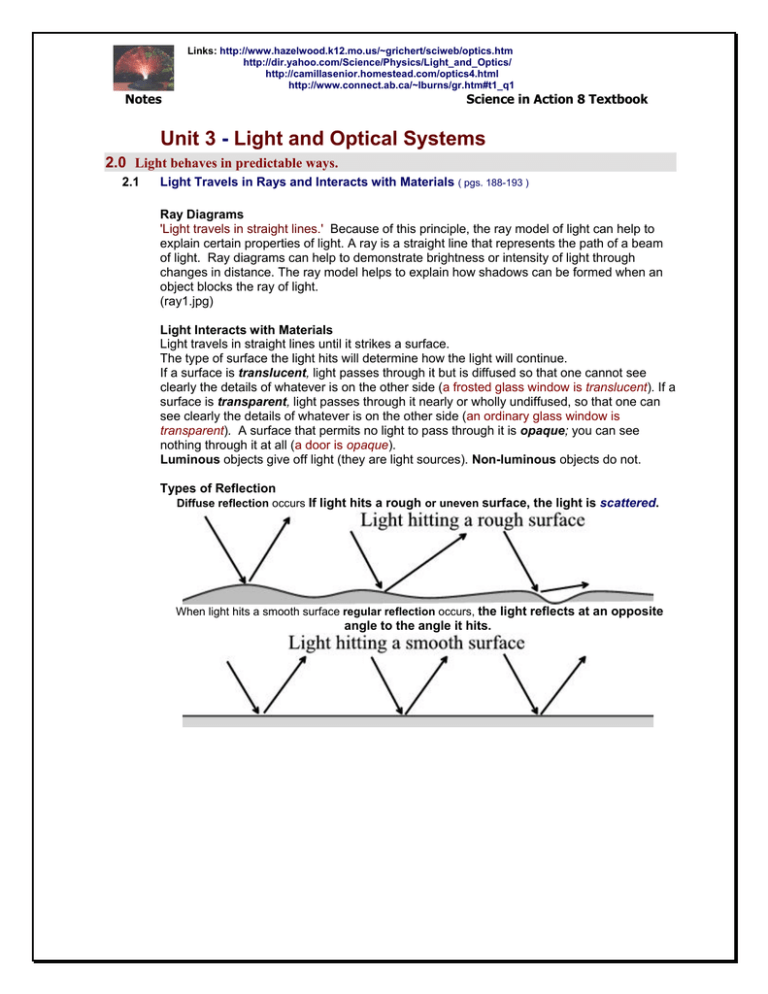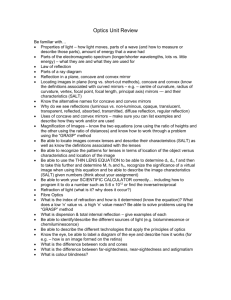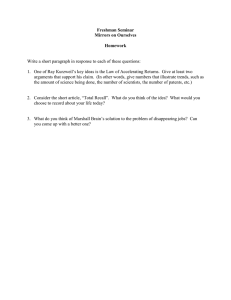View as Printable PDF
advertisement

Links: http://www.hazelwood.k12.mo.us/~grichert/sciweb/optics.htm http://dir.yahoo.com/Science/Physics/Light_and_Optics/ http://camillasenior.homestead.com/optics4.html http://www.connect.ab.ca/~lburns/gr.htm#t1_q1 Notes Science in Action 8 Textbook Unit 3 - Light and Optical Systems 2.0 Light behaves in predictable ways. 2.1 Light Travels in Rays and Interacts with Materials ( pgs. 188-193 ) Ray Diagrams 'Light travels in straight lines.' Because of this principle, the ray model of light can help to explain certain properties of light. A ray is a straight line that represents the path of a beam of light. Ray diagrams can help to demonstrate brightness or intensity of light through changes in distance. The ray model helps to explain how shadows can be formed when an object blocks the ray of light. (ray1.jpg) Light Interacts with Materials Light travels in straight lines until it strikes a surface. The type of surface the light hits will determine how the light will continue. If a surface is translucent, light passes through it but is diffused so that one cannot see clearly the details of whatever is on the other side (a frosted glass window is translucent). If a surface is transparent, light passes through it nearly or wholly undiffused, so that one can see clearly the details of whatever is on the other side (an ordinary glass window is transparent). A surface that permits no light to pass through it is opaque; you can see nothing through it at all (a door is opaque). Luminous objects give off light (they are light sources). Non-luminous objects do not. Types of Reflection Diffuse reflection occurs If light hits a rough or uneven surface, the light is scattered. When light hits a smooth surface regular reflection occurs, the light reflects at an opposite angle to the angle it hits. Links: http://www.hazelwood.k12.mo.us/~grichert/sciweb/optics.htm http://dir.yahoo.com/Science/Physics/Light_and_Optics/ http://camillasenior.homestead.com/optics4.html http://www.connect.ab.ca/~lburns/gr.htm#t1_q1 Notes 2.2 Science in Action 8 Textbook The Law of Reflection ( pgs. 194-196 ) Reflection is the process in which light strikes a surface and bounces back off that surface. How it bounces off the surface depends on the Law of Reflection and the type of surface it hits. Light coming from a light source is called an incident ray and the light that bounces off the surface is called a reflected ray. A line that is perpendicular ( 90o with the surface ) to the plane mirror is called the normal line. The angle between the incident ray and the normal line is called the angle of incidence ( i ). The angle between the reflected ray and the normal line is called the angle of reflection ( r ). Light Source The Law of reflection states that: the angle of incidence equals the angle of reflection the incident ray, the normal line and the reflected ray all lie in the same plane (an imaginary flat surface) Figure 2.12 p. 196 2.3 Reflecting Light with Curved Mirrors ( pgs. 197-199 ) An image is formed in a mirror because light reflects off all points on the object being observed in all directions. The rays that reach your eye appear to be coming from a point behind the mirror. Because your brain knows that light travels in a straight line, it interprets the pattern of light that reaches your eye as an image of an object you are looking at. This site shows an animation of how an image is formed in a mirror. (EXCELLENT) http://www.glenbrook.k12.il.us/gbssci/phys/Class/refln/u13l2a.html (Figure 2.13 in the Science in Action Textbook shows how an image in a mirror can be distorted.) Mirrors that cave in are called Concave mirrors Concave mirrors form an image that appears to be closer than it actually is and can be useful because it can also reflect light from a large area Focal point is in front of mirror security devices, flashlights, telescopes, cosmetic mirrors and car headlights Mirrors that bulge out are called Convex mirrors Convex mirrors form images that appear much smaller and farther away than the object - but they can reflect light from a large area Focal point is in behind mirror rear-view mirrors and side mirrors on automobiles Links: http://www.hazelwood.k12.mo.us/~grichert/sciweb/optics.htm http://dir.yahoo.com/Science/Physics/Light_and_Optics/ http://camillasenior.homestead.com/optics4.html http://www.connect.ab.ca/~lburns/gr.htm#t1_q1 Notes 2.4 Science in Action 8 Textbook Transparent Substances Refract Light ( pgs. 200-203 ) Refraction is the process in which light is bent, when it travels from one medium to another. Light bends because it changes speed when it moves through materials that have different densities. The bending of light makes the object's image appear to be in a different position than it really is. This site shows the angles of how a fish should be caught with a spear. (VERY Detailed Explanation) http://www.glenbrook.k12.il.us/gbssci/phys/Class/refln/u13l2a.html How Light Refracts Light travels slower in materials that are denser, because there are more particles. The Law of Refraction states that when light travels from one medium, to a more dense medium, the light will be bent toward the normal, and when it exits the denser medium into a less dense medium it will bend away from the normal. The new direction of light is called the angle of refraction. Mirage Refraction can also occur when light travels through air at different temperatures, because warm air is less dense than cold air. The refraction of light through air is called a mirage. What happens when light strikes a surface? What happens to light Type of behavior Nature of surface What else happens? striking a surface Absorption Energy Transformation rough, dark, opaque some light is reflected Reflection Bounces off smooth, shiny some light is absorbed Travels through in a different transparent Refraction some light is reflected new direction medium Links: http://www.hazelwood.k12.mo.us/~grichert/sciweb/optics.htm http://dir.yahoo.com/Science/Physics/Light_and_Optics/ http://camillasenior.homestead.com/optics4.html http://www.connect.ab.ca/~lburns/gr.htm#t1_q1 Notes 2.5 Science in Action 8 Textbook Lenses Refract and Focus Light ( pgs. 204-208 ) A lens is a curved piece of transparent material (glass/plastic). When light rays pass through it, the light is refracted, causing the rays to bend. A double concave lens is thinner and flatter in the middle than the edges. Light passing through the thicker more curved areas of the lens will bend more than light passing through the thinner areas, causing the light to spread out or diverge. A double convex lens is thicker in the middle than around the edges. This causes the light to come together at a focal point, or converge. Lenses and Mirrors Lenses are useful optical devices. Eyeglasses, have been made from lenses since the thirteenth century. A convex lens refracts the light rays from an object so they can be focused. Different size lenses can converge the light rays at different distances, enabling corrections to be made to focal points. However, light from the left portion of the object is directed to the right and the light from the top is directed to the bottom. This inverts the image. Overhead projectors and film projectors do this. Image Formation With A Convex Lens The formation of an image with a double convex lens depends on where the object is placed and the orientation of the light source.


